Driving Path and System Simulation of Green Innovation Capability of Science and Technology Enterprises in Yangtze River Delta
Abstract
1. Introduction
2. Literature Review
2.1. The Concept of Green Innovation Capability
2.2. Evaluation Method of Green Innovation Capability
2.3. Influencing Factors of Green Innovation Capability
3. Materials and Methods
3.1. System Structure Analysis
3.1.1. System Boundaries and Assumptions
3.1.2. System Element Analysis and Subsystem Division
3.2. SD Model Construction and Simulation
3.2.1. Construction of Causality Diagram
3.2.2. Flow Stock Diagram
3.2.3. Determination of Simulation Variables and Parameters
3.2.4. Model Test
4. Results
4.1. Influence of Government R&D Investment Dimension
4.2. Influence of Technological Innovation Dimension
4.3. Influence of R&D Achievements Transformation Dimension
4.4. Comparison of Policies and Schemes
5. Discussion
- (1)
- Strengthen policy support for the green innovation of enterprises. According to the causal source chart, the government’s R&D investment has an indirect effect on the green innovation capability of enterprises. In the process of improving the green innovation ability of enterprises, the government plays the role of baton. As a result, government departments should continue to strengthen efforts to actively create an external environment for green innovation, optimize the development environment for green innovation and relevant laws and regulations, pay attention to the joint use of mandatory and incentive regulatory policies, and strengthen policy constraints and incentives.
- (2)
- Intensify the transfer and transformation of scientific and technological achievements. The transformation of scientific and technological achievements is a systematic project, which needs cross-departmental, cross-field and cross-professional cooperation. The transformation of scientific and technological achievements in universities and research institutes is not only a problem of its own, but also a problem of the construction of the economic chain for the transformation of scientific and technological achievements [52]. This not only requires universities and research institutes to improve the ability to transform scientific and technological achievements, but also needs guidance from the policy and management level, and support from the market management level. The economic environment and economic chain for the transformation of scientific and technological achievements should be activated to enhance the ability and efficiency of the transformation of scientific and technological achievements in universities and research institutes. We will foster a healthy new environment for scientific and technological research, and form an efficient and orderly economic system for transforming scientific and technological achievements. Therefore, relevant departments gradually improve and improve the classification and evaluation system of scientific and technological achievements, step by step across the gap in the transformation of scientific and technological achievements, and effectively display the role of scientific and technological achievements evaluation “baton”, so that the adaptation to industrial development, fresh scientific and technological achievements get the best transformation. In addition, it is necessary to fully and accurately reflect the innovation level of scientific and technological achievements, improve the construction of the ecological system for the transformation of scientific and technological achievements, and explore the high-quality supply of achievements and the transformation and application path.
- (3)
- Improve the R&D capacity of innovation subjects. Increasing the investment in high-tech talents and R&D investment of scientific research institutions can positively improve the knowledge innovation ability and the efficiency of new product research and development, so as to promote the green innovation ability of science and technology enterprises. As the saying goes, the key to innovation depends on talent. Increasing investment in high-level talents in education, creating a multi-value and demand-oriented classification and evaluation system, stimulating the enthusiasm and the sense of mission of scientific and technological personnel and technology transformation personnel, and improving the social value and sense of honor of technology transfer talents can fully mobilize the enthusiasm of all kinds of innovation subjects [53]. The application of scientific research innovation can be strengthened and the application innovation of scientific research achievements can be promoted through the continuous joining of scientific and technological achievements transformation team. Finally, the transformation efficiency of scientific and technological achievements is greatly improved, and the benefit of green innovation is improved.
- (4)
- Improve the mechanism of industry, university and research cooperation in the Yangtze River Delta region. It can be seen intuitively from the feedback loop that the improvement of the degree of industry-university-research cooperation can accelerate the efficiency of new product research and development, and then promote the enhancement of the technological innovation ability of enterprises, and finally improve the green innovation ability of science and technology enterprises. Therefore, in the green innovation system, enterprises, universities and scientific research institutions are the direct subjects of green innovation, while governments and financial institutions participate in green innovation as indirect subjects. Through the sharing of ideas, knowledge, technology and opportunities, the main body of the green innovation system can create innovation across the boundaries of enterprises, and then enhance the green innovation power of science and technology enterprises. Therefore, the main body of the green innovation system should avoid and prevent the “island phenomenon” in scientific and technological innovation, promote the efficient cooperation of industry, university and research, and improve the effect of the transformation of scientific and technological achievements. We should encourage all kinds of research institutes to cooperate with schools and enterprises; build independent innovation research and development platforms; build advanced expert teams; consolidate the theoretical basis of scientific and technological innovation and advanced technical support; and actively introduce their scientific and technological achievements into the market.
Author Contributions
Funding
Informed Consent Statement
Data Availability Statement
Conflicts of Interest
References
- China Economic News Network. Technological Innovation Enabling Enterprises to Build Green Development Model. Available online: https://jjsb.cet.com.cn/show_512318.html (accessed on 27 December 2019).
- Cheng, H. Construction of Evaluation Index System for Green Innovation Capability of Resource-based Cities. Sci. Technol. Manag. Res. 2019, 39, 90–97. [Google Scholar]
- Zhang, W.Y.; Yu, Q.; Yang, F.X. Evaluation of Green Innovation ability of Regional Manufacturing Industry under Innovation Driven Strategy—Modeling and Analysis of Complex Network Based on 30 Regional Data. J. Ind. Technol. Econ. 2018, 37, 86–94. [Google Scholar]
- Xu, J.Z.; Sun, Y.; Sun, X.G. Study of the Environmental Innovation Capability Evaluation Model of Manufacturing Enterprises Based on Entropy Weighted TOPSIS-PSO-ELM and Empirical Research. Oper. Res. Manag. Sci. 2020, 29, 131–140. [Google Scholar]
- Sun, Z.Q.; Nie, W.Y. The Impact of Financial Information Transparency under the Carbon Neutrality Target on the Regional Green Innovation Capability: Based on the Dual Perspective of Spatial Spillover Effect and Threshold Effect. Sci. Technol. Prog. Policy 2021, 38, 58–66. [Google Scholar]
- Wang, H.R.; Cui, H.R.; Zhao, Q.Z. Effect of Green Technology Innovation on Green Total Factor Productivity in China: Evidence from Spatial Durbin Model Analysis. J. Clean. Prod. 2020, 288, 125624. [Google Scholar] [CrossRef]
- Sun, Q.Y.; Zhu, Z.F.; Cao, Y.K. Evaluation and Analysis on China’s Provincial Regional Green Innovation Capability in the Perspective of Low Carbon Economy—A Case Study of Heilongjiang Province. For. Econ. 2019, 41, 34–42. [Google Scholar]
- Gupta, H.; Barua, M.K. Supplier selection among SMEs on the basis of their green innovation ability using BWM and fuzzy TOPSIS. J. Clean. Prod. 2017, 152, 242–258. [Google Scholar] [CrossRef]
- Musaad, O.A.S.; Zhuo, Z.; Siyal, Z.A.; Shaikh, G.M.; Shah, S.A.A.; Solangi, Y.A.; Musaad, O.A.O. An Integrated Multi-Criteria Decision Support Framework for the Selection of Suppliers in Small and Medium Enterprises based on Green Innovation Ability. Processes 2020, 8, 418. [Google Scholar] [CrossRef]
- Joseph, A.S. Theory of Economic Development; The Commercial Press: Beijing, China, 1990. [Google Scholar]
- Tura, T.; Harmaakorpi, V. Social Capital in Building Regional Innovative Capability. Reg. Stud. 2005, 39, 1111–1125. [Google Scholar] [CrossRef]
- Qi, G.Y.; Shen, L.Y.; Zeng, S.X.; Jorge, O.J. The Drivers for Contractors’ Green Innovation: An Industry Perspective. J. Clean. Prod. 2010, 18, 1358–1365. [Google Scholar] [CrossRef]
- Cao, H.; Shi, B.F.; Zhao, K. Evaluation on Provincial Green Innovation Capability: Based on Index Screening Model of Collinearity-Coefficient of Variation. Chin. J. Manag. 2016, 13, 1215–1222. [Google Scholar]
- Braun, E.; Wield, D. Regulation as a Means for the Social Control of Technology. Technol. Anal. Strateg. Manag. 1994, 6, 259–272. [Google Scholar] [CrossRef]
- Ge, S.S.; Zeng, G.; Hu, H. Evaluation of Green Innovation ability and Analysis of Spatial Characteristics in the Yangtze River Delta Urban Agglomeration. Resour. Environ. Yangtze Basin 2021, 30, 1–10. [Google Scholar]
- Lee, K.H.; Min, B. Green R&D for Eco-innovation and its Impact on Carbon Emissions and Firm Performance. J. Clean. Prod. 2015, 108, 534–542. [Google Scholar]
- Zhang, Y.Z.; Zhang, T.H. Evaluation Index System of Enterprise Green Innovation Capability and its Improvement Countermeasures. Econ. Res. Guide 2017, 32, 12–14. [Google Scholar]
- Yousaf, Z. Go for Green: Green Innovation through Green Dynamic Capabilities: Accessing the Mediating Role of Green Practices and Green Value Co-creation. Environ. Sci. Pollut. Res. 2021, 28, 54863–54875. [Google Scholar] [CrossRef]
- Tseng, M.L.; Wang, R.; Chiu, A.S.F.; Yong, G.; Yuan, H.L. Improving Performance of Green Innovation Practices under Uncertainty. J. Clean. Prod. 2013, 40, 71–82. [Google Scholar] [CrossRef]
- Singh, S.K.; Del Giudice, M.; Jabbour, C.J.C.; Latan, H.; Sohal, A.S. Stakeholder Pressure, Green Innovation, and Performance in Small and Medium-sized Enterprises: The role of Green Dynamic Capabilities. Bus. Strategy Environ. 2022, 31, 500–514. [Google Scholar] [CrossRef]
- Wang, Y.; Liang, Z.L.; Chen, H.C. Influence Mechanism of Technical Innovation Capability on Green Economic Growth. J. Environ. Prot. Ecol. 2020, 21, 1972–1984. [Google Scholar]
- Qiu, L.; Jie, X.; Wang, Y. Green Product Innovation, Green Dynamic Capability, and Competitive Advantage: Evidence from Chinese Manufacturing Enterprises. Corp. Soc. Responsib. Environ. Manag. 2020, 27, 146–165. [Google Scholar] [CrossRef]
- Huang, S.Z.; Chau, K.Y.; Chien, F. The Impact of Startups’ Dual Learning on Their Green Innovation Capability: The Effects of Business Executives’ Environmental Awareness and Environmental Regulations. Sustainability 2020, 12, 6526. [Google Scholar] [CrossRef]
- Ardyan, E.; Nurtantiono, A.; Istiyanto, B.; Rahmawan, G. Green innovation capability as driver of sustainable competitive advantages and smes marketing performance. Int. J. Civ. Eng. Technol. 2017, 8, 1114–1122. [Google Scholar]
- Deng, Y.P.; Wang, L.; Zhou, W.J. Research on the Evolution of Manufacturing Green Technology Innovation Capability Based on Industry Heterogenity—Also on the Influence of R&D Investment of Enterprises. Stat. Res. 2021, 38, 76–86. [Google Scholar]
- Tan, D.Q.; Shang, L.N. Influence of Environmental Regulation on Regional Green Innovation Capability from the Perspective of Manufacturing Upgrading. Acad. Forum 2018, 41, 86–92. [Google Scholar]
- Liu, Z.S.; Song, D.Y.; Gong, Y.Y. Research on Spatial-temporal Difference and Convergence of Green Innovation Capability in China. Chin. J. Manag. 2017, 14, 1475–1483. [Google Scholar]
- Xu, J.Z.; Guan, J. Study on the Environmental Innovative Capability Evaluation Model of Manufacturing Enterprises Based on Combination Weight of Two-Tuple Linguistic Method and Empirical Research. Oper. Res. Manag. Sci. 2017, 26, 124–131. [Google Scholar]
- Dai, W.L.; Lu, W.L. The Impact of Environmental Public Opinion Pressure on Manufacturing Firms Green Innovation Capability: The Chain Mediating Role of Leader Environmental Awareness and Organizational Green Learning. Sci. Technol. Prog. Policy 2020, 37, 131–137. [Google Scholar]
- Sun, Z.Q.; Bian, M.J.; Chen, W.Q. Study on Spillover Effect of Regional Green Innovation Aability in China. Ecol. Econ. 2019, 35, 71–76+93. [Google Scholar]
- Han, Y.Q.; Lu, H.; Shi, J.P. Internet Development, Environmental Regulation and Green Innovation Efficiency of High-Tech Industries—Take the Yangtze River Economic Belt as an Example. Resour. Environ. Yangtze Basin 2022, 1–18. Available online: http://kns.cnki.net/kcms/detail/42.1320.X.20220526.2033.002.html (accessed on 27 May 2022).
- Jiang, S.Y. Research on Entrepreneur Human Capital Affects the Company’s Green Innovation Capability. J. Tech. Econ. Manag. 2021, 3, 40–44. [Google Scholar]
- Zhang, Y.L.; Xu, L.; Wang, J.H. Driving Path of High-quality Development of Technology-based SMEs from Perspective of Green Innovation. Enterp. Econ. 2022, 41, 13–23. [Google Scholar]
- Sun, Y.; Xu, J. Evaluation Model and Empirical Research on the Green Innovation Capability of Manufacturing Enterprises from the Perspective of Ecological Niche. Sustainability 2021, 13, 11710. [Google Scholar] [CrossRef]
- Zou, H.; Ji, H.M.; Qin, H.; Guo, Y.Q.; Yang, X.H. Research on the Strategy Evolution of Knowledge Innovation in an Enterprise Digital Innovation Ecosystem: Kinetic and Potential Perspectives. IEEE Access 2022, 10, 78764–78779. [Google Scholar] [CrossRef]
- Liu, H.Y.; Zhao, S.K.; Xin, O. Analysis on the Evolution Path and Hotspot of Knowledge Innovation Study Based on Knowledge Map. Sustainability 2019, 11, 5528. [Google Scholar] [CrossRef]
- Bag, S.; Dhamija, P.; Bryde, D.J.; Singh, R.K. Effect of Eco-innovation on Green Supply Chain Management, Circular Economy Capability, and Performance of Small and Medium Enterprises. J. Bus. Res. 2022, 141, 60–72. [Google Scholar] [CrossRef]
- Xin, D.; Sheng, Z.Z.; Sun, J.H. How Technological Innovation Influences Environmental Pollution: Evidence from China. Complexity 2022, 2022, 5535310. [Google Scholar] [CrossRef]
- Shi, Z.; Wu, Y.J.; Chiu, Y.H.; Chang, T.H. Research on the Influence of Technological Innovation and Technological Application: Evidence from China. J. Eng. Technol. Manag. 2021, 63, 101670. [Google Scholar] [CrossRef]
- Zhu, H.X.; Geng, D.C. Dynamic Simulation Research on Green innovation Competitiveness of Shanghai, Jiangsu, Zhejiang and Anhui: Based on System Dynamics Perspective. Sci. Technol. Manag. Res. 2022, 42, 16–26. [Google Scholar]
- Bao, H.; Teng, T.W.; Hu, S.L.; Ding, J. Spatial Differentiation and Influencing Factors of Urban Green Innovation Efficiency in the Yangtze River Delta. Resour. Environ. Yangtze Basin 2022, 31, 273–284. [Google Scholar]
- Wang, H.; Khan, M.; Anwar, F.; Shahzad, F.; Adu, D.; Murad, M. Green Innovation Practices and Its Impacts on Environmental and Organizational Performance. Front. Psychol. 2021, 11, 553625. [Google Scholar] [CrossRef] [PubMed]
- Lin, W.L.; Ho, J.A.; Sambasivan, M.; Yip, N.; Mohamed, A.B. Influence of Green Innovation Strategy on Brand Value: The Role of Marketing Capability and R&D Intensity. Technol. Forecast. Soc. Change 2021, 171, 120946. [Google Scholar]
- Yu, C.H.; Wu, X.; Zhang, D.; Chen, S.; Zhao, J. Demand for green finance: Resolving financing constraints on green innovation in China. Energy Policy 2021, 153, 112255. [Google Scholar] [CrossRef]
- Xu, Z.; He, Y.; Wang, H. Factors Affecting Government R&D Funding and Enterprise R&D Behavior Based on System Dynamics. Manag. Rev. 2012, 24, 67–75. [Google Scholar]
- Romer, P. Endogenous Technological Change. J. Political Econ. 1990, 98, 71–102. [Google Scholar] [CrossRef]
- Park, W.G. A Theoretical Model of Government Research and Growth. J. Econ. Behav. Organ. 1998, 34, 69–85. [Google Scholar] [CrossRef]
- Zhang, X.; Wang, Y. Effect of Environmental Regulation and R&D Investment on Green Technological Innovation. Sci. Technol. Prog. Policy 2017, 34, 111–119. [Google Scholar]
- Qian, L.; Wang, W.P.; Xiao, R.Q. Research on the Difference of Green Innovation Efficiency of China’s Regional Industrial Enterprises from the Perspective of Shared Input Association. China Popul. Resour. Environ. 2018, 28, 27–39. [Google Scholar]
- Wu, Z.; Zhao, C.; Mei, C. Research on Scientific & Technological Achievements Transformation of Sichuan Provincial State-Owned Enterprises of China. Am. J. Ind. Bus. Manag. 2016, 6, 815–821. [Google Scholar]
- Guan, X.X.; Deng, K.; Qi, Q.R. Research and Application of Computer Technology in the Transformation Mode of Scientific and Technological Achievements in Chinese Universities. J. Phys. Conf. Ser. 2020, 1648, 032106. [Google Scholar] [CrossRef]
- Zhou, L.; Cao, C. The Hybrid Drive Effects of Green Innovation in Chinese Coal Enterprises: An Empirical Study. Kybernetes 2019, 49, 362–383. [Google Scholar] [CrossRef]
- Ouyang, L.; You, D. The Green Innovation Effect on Heavy-Polluting Enterprises Under the Environmental Protection Law. Front. Energy Res. 2021, 9, 681334. [Google Scholar] [CrossRef]
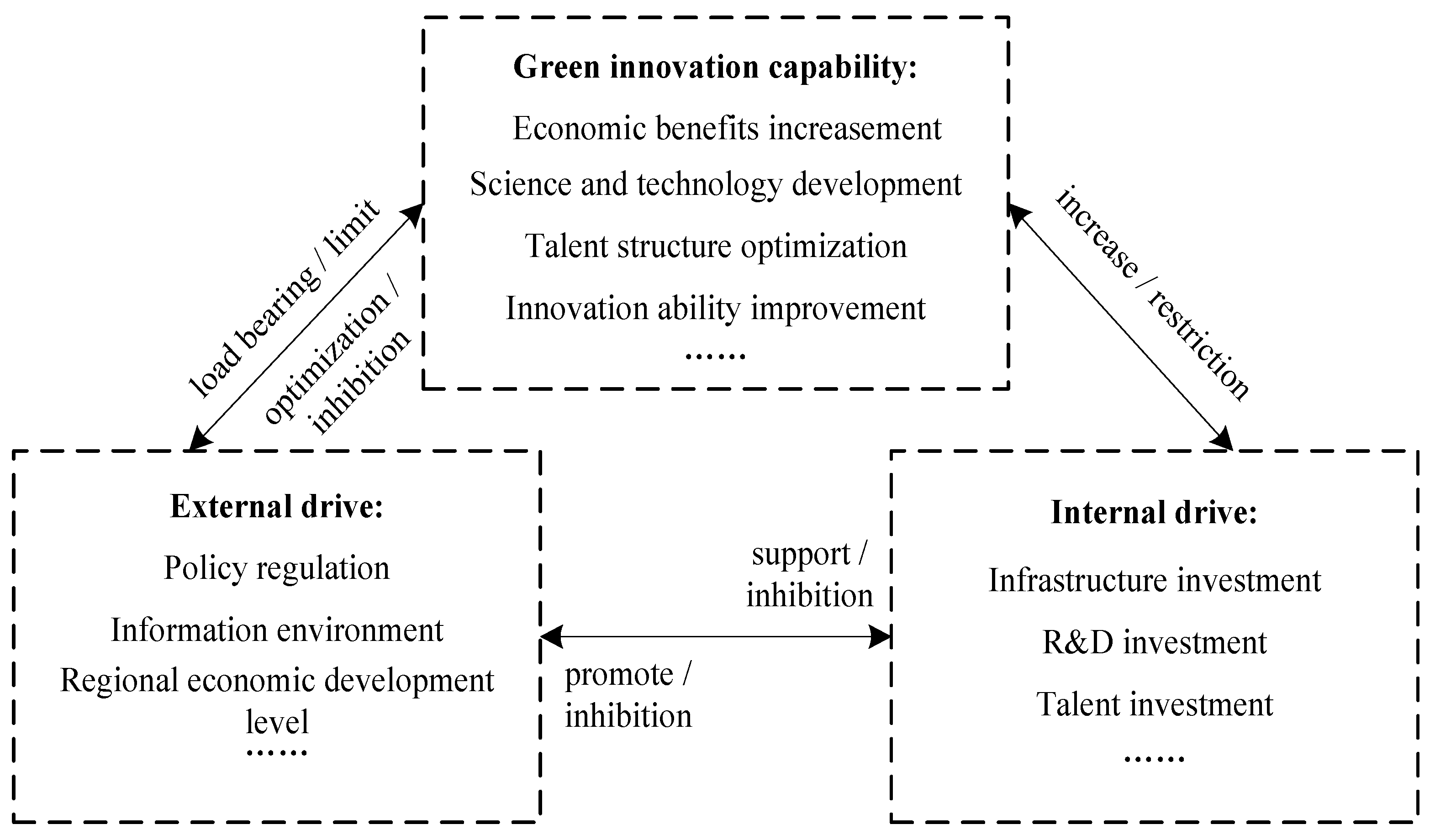
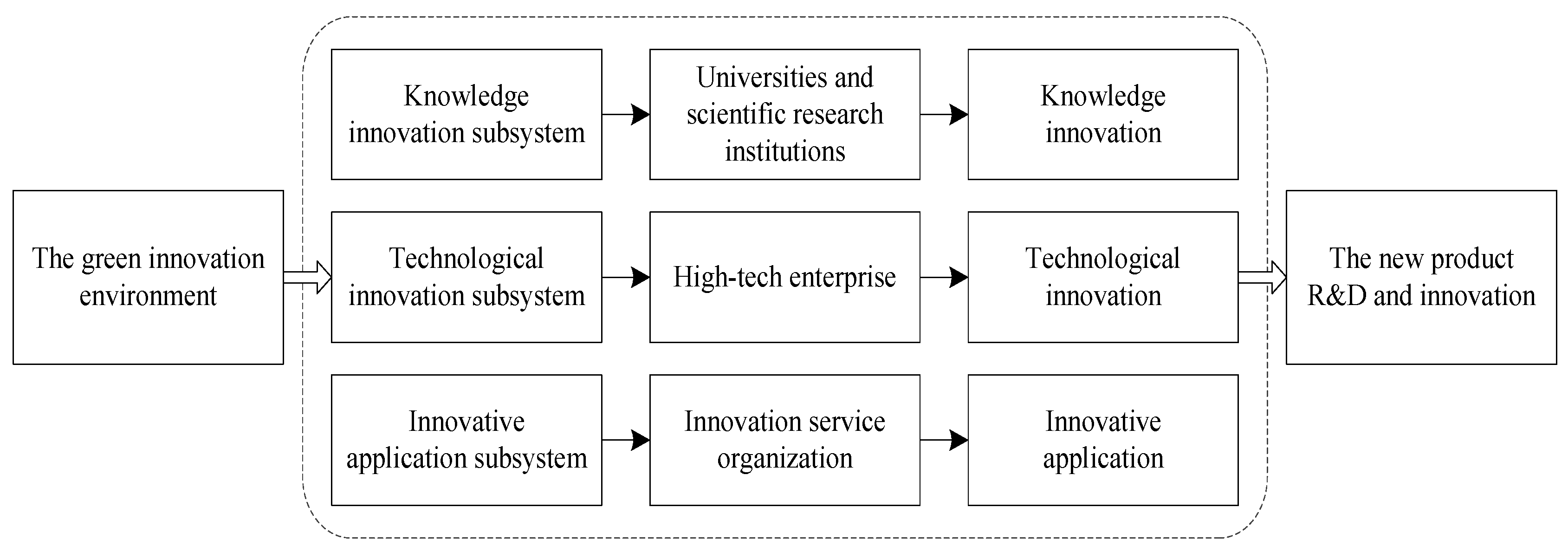
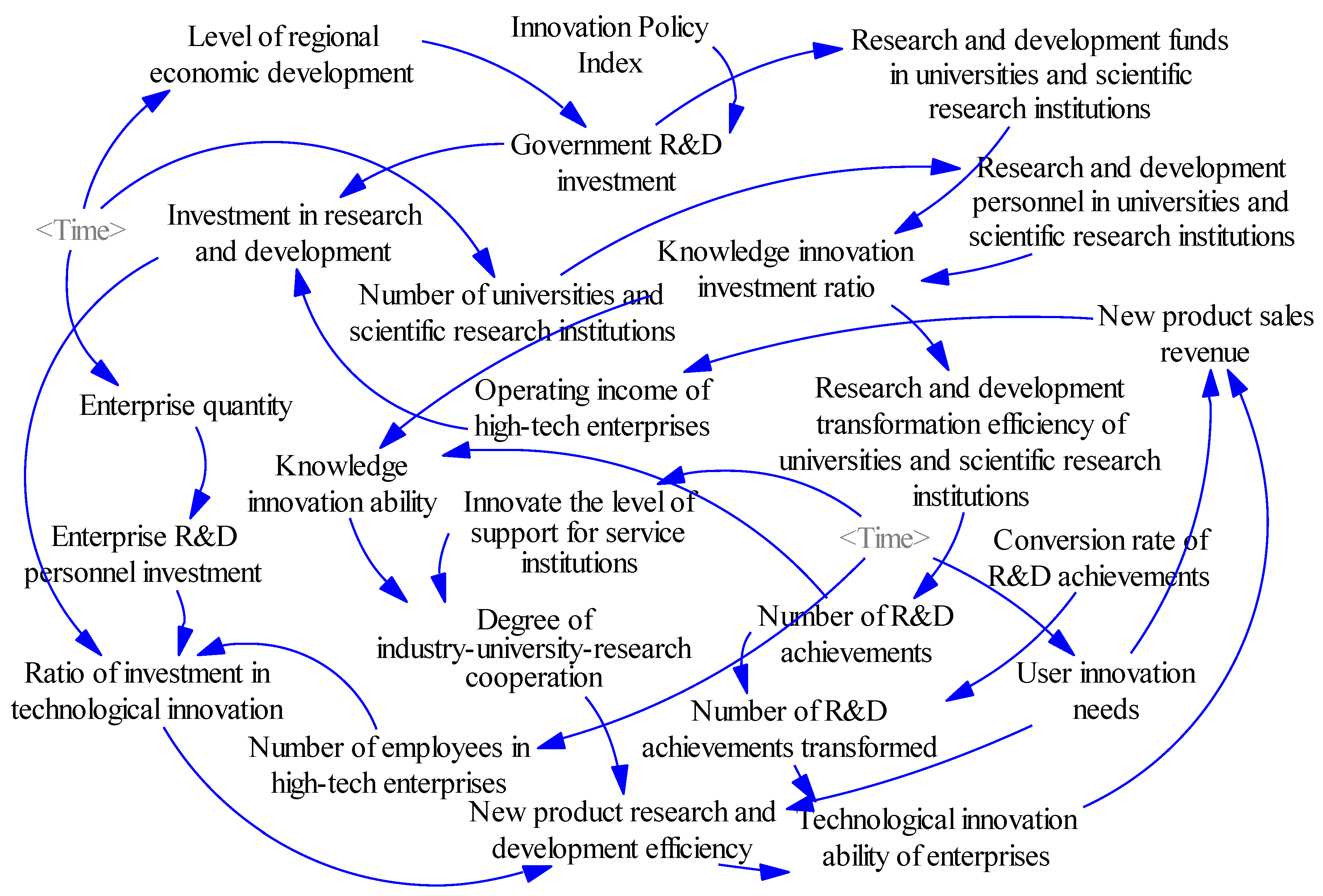
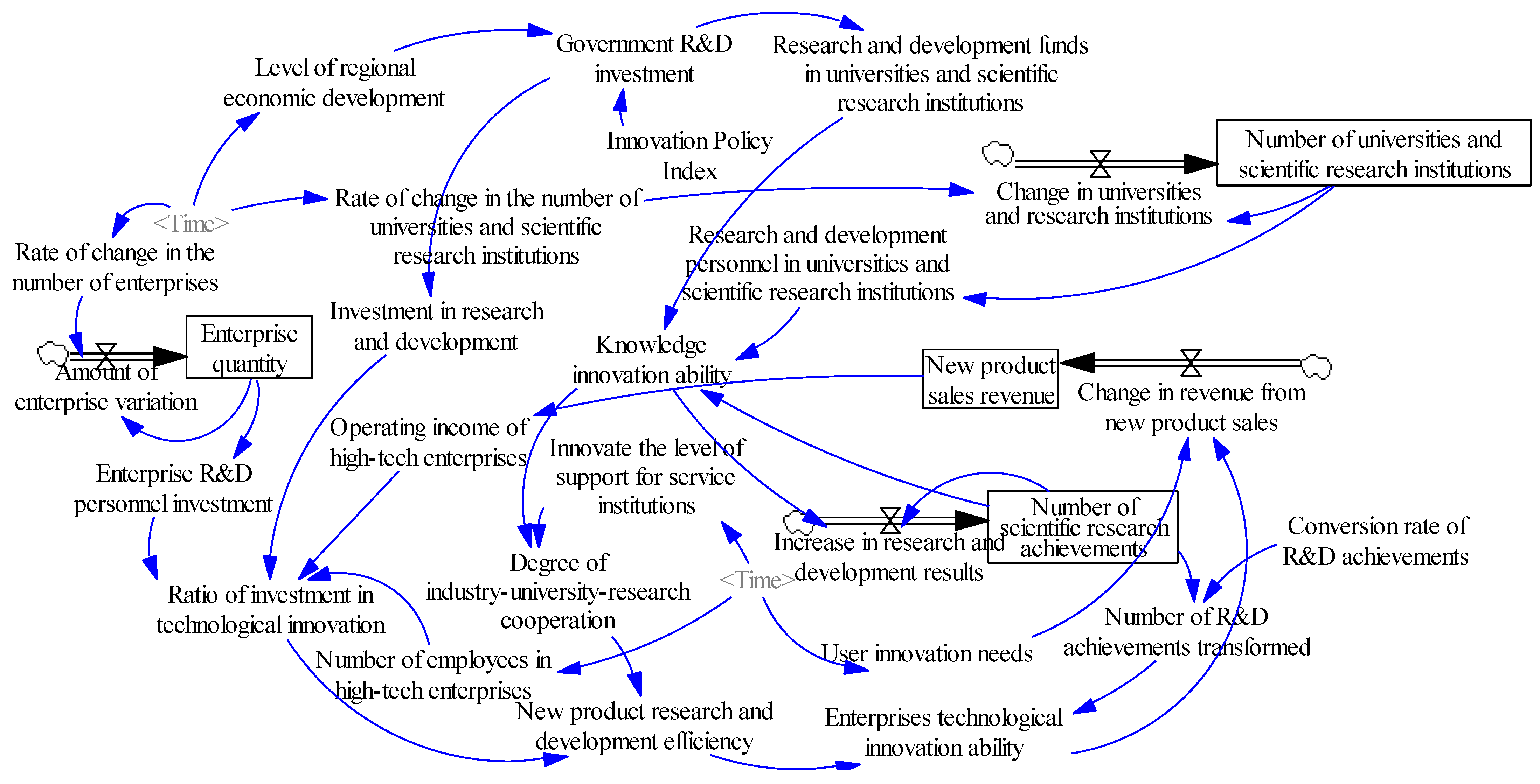

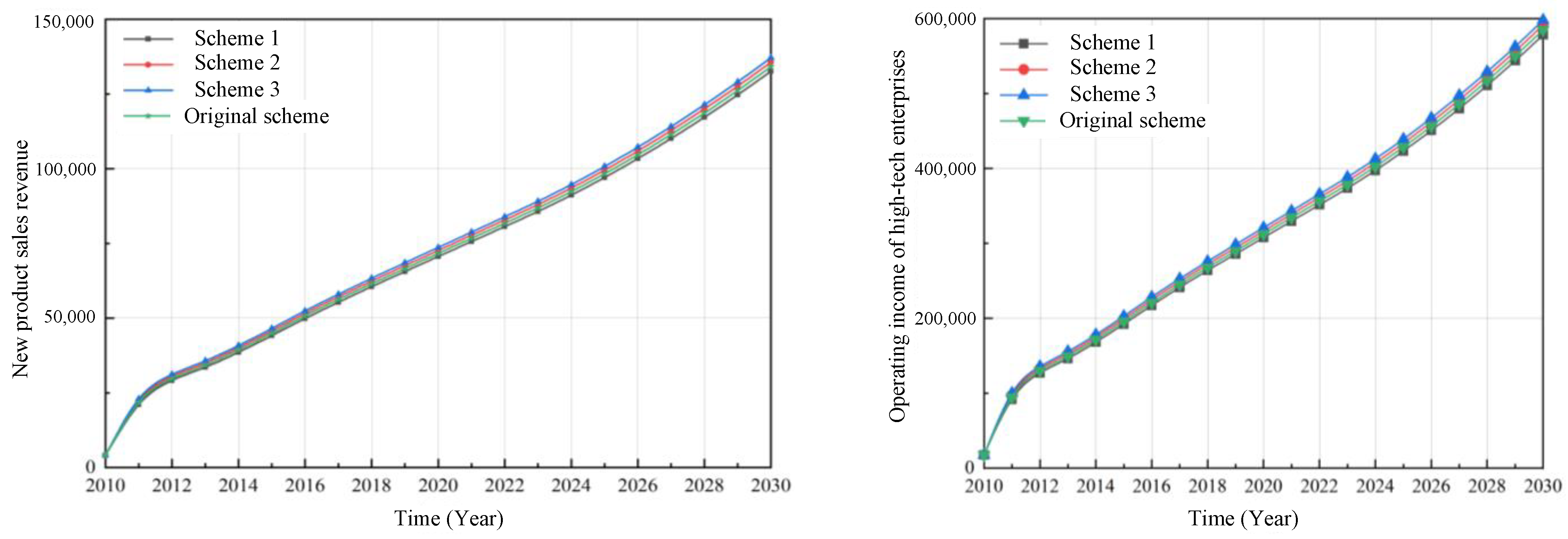
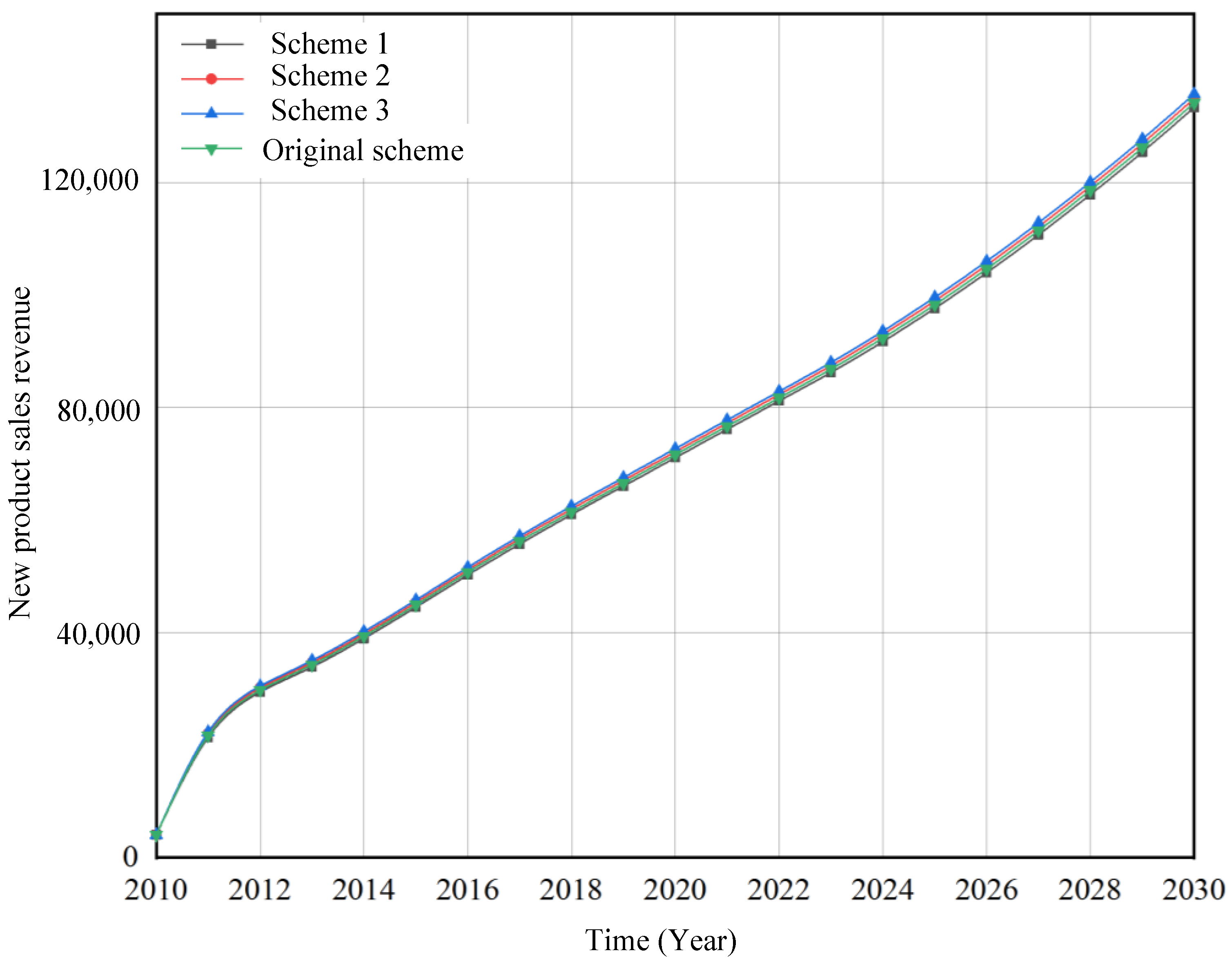
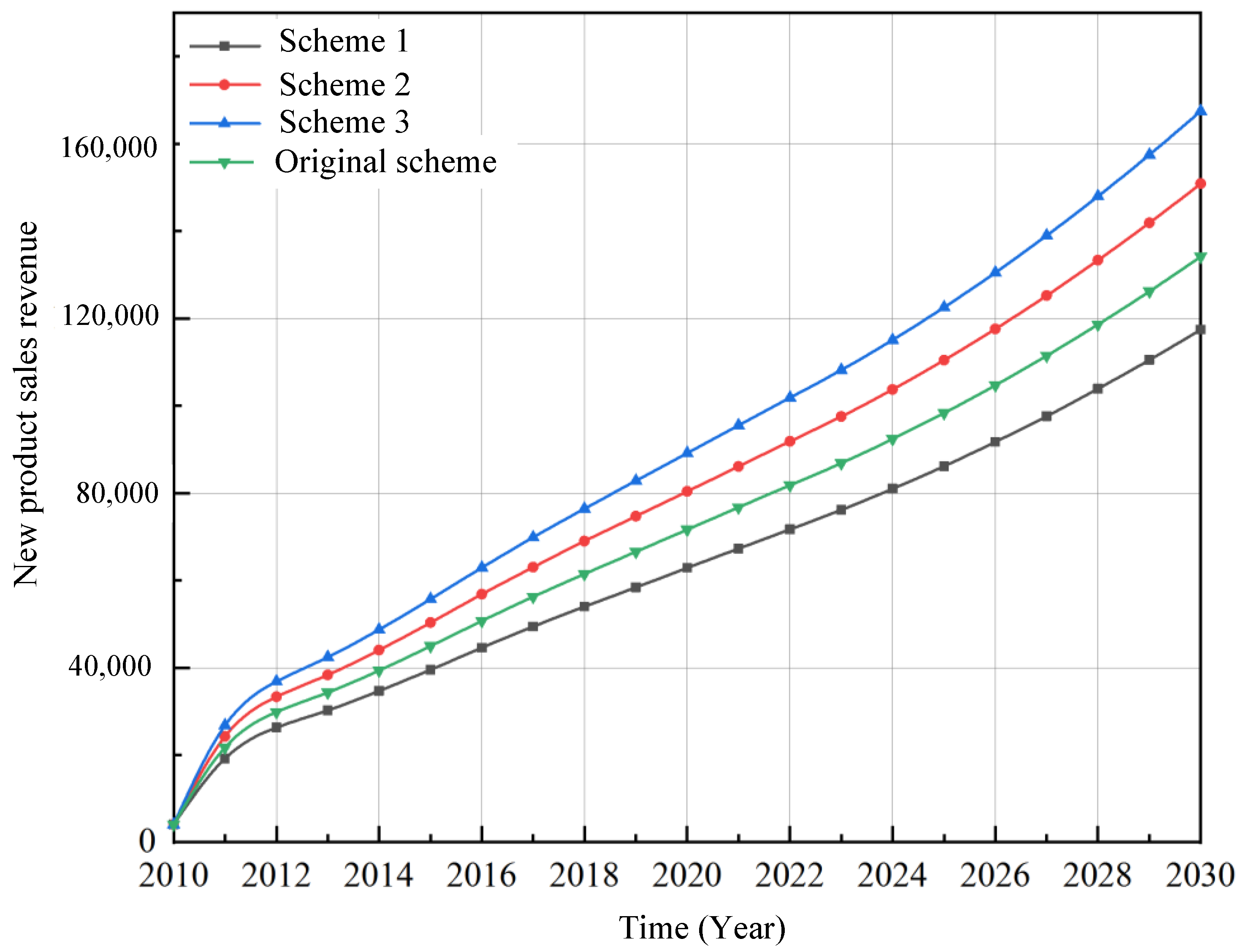
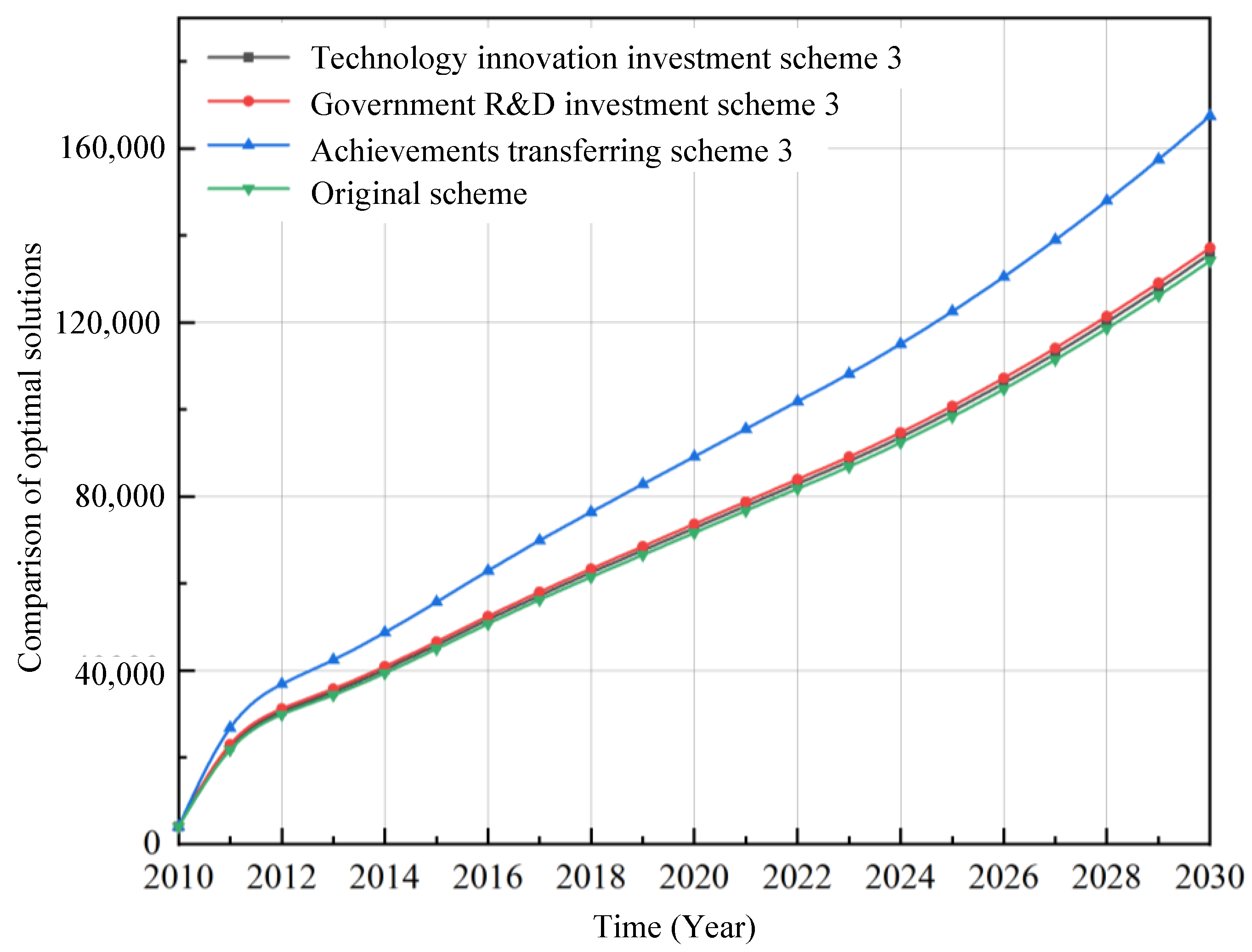

| Ordinal | Variable | Variable Equation |
|---|---|---|
| 1 | Innovation policy index | Innovation policy index = 0.027 |
| 2 | R&D Investment in universities and research institutions | R&D Investment in universities and research institutions = 0.17 × R&D investment by the government |
| 3 | Investment of R&D personnel in universities and scientific research institutions | Investment of R&D personnel in universities and scientific research institutions = 96.01 × Number of universities and scientific research institutions |
| 4 | Number of scientific research achievements | Number of scientific research achievements = INTEG (Increased number of R&D achievements, 121,900) |
| 5 | Increased number of R&D achievements | Increased number of R&D achievements = 0.187 × Number of research achievements × knowledge innovation ability |
| 6 | Conversion rate of scientific research achievements | Conversion rate of scientific research achievements = 0.14 |
| 7 | Number of enterprises | Number of enterprises = INTEG (change of enterprises, 9630) |
| 8 | Investment of R&D personnel | Investment of R&D personnel = 26.92 × Number of enterprises |
| 9 | Enterprise R&D investment | Enterprise R&D investment = 0.51 × Government R&D investment |
| 10 | Change in sales revenue of new products | Change in sales revenue of new products = 0.014 × Enterprise technology innovation capability × user demand |
| 11 | Sales revenue of new products | Sales revenue of new products = INTEG (Change in sales revenue of new products, 4066.75) |
| 12 | Operating Income of technology-based enterprises | Operating Income of technology-based enterprises = 4.36 × Sales revenue of new products |
Publisher’s Note: MDPI stays neutral with regard to jurisdictional claims in published maps and institutional affiliations. |
© 2022 by the authors. Licensee MDPI, Basel, Switzerland. This article is an open access article distributed under the terms and conditions of the Creative Commons Attribution (CC BY) license (https://creativecommons.org/licenses/by/4.0/).
Share and Cite
Zhu, Y.; He, G.; Bao, K. Driving Path and System Simulation of Green Innovation Capability of Science and Technology Enterprises in Yangtze River Delta. Sustainability 2022, 14, 13031. https://doi.org/10.3390/su142013031
Zhu Y, He G, Bao K. Driving Path and System Simulation of Green Innovation Capability of Science and Technology Enterprises in Yangtze River Delta. Sustainability. 2022; 14(20):13031. https://doi.org/10.3390/su142013031
Chicago/Turabian StyleZhu, Yanna, Gang He, and Keyu Bao. 2022. "Driving Path and System Simulation of Green Innovation Capability of Science and Technology Enterprises in Yangtze River Delta" Sustainability 14, no. 20: 13031. https://doi.org/10.3390/su142013031
APA StyleZhu, Y., He, G., & Bao, K. (2022). Driving Path and System Simulation of Green Innovation Capability of Science and Technology Enterprises in Yangtze River Delta. Sustainability, 14(20), 13031. https://doi.org/10.3390/su142013031






